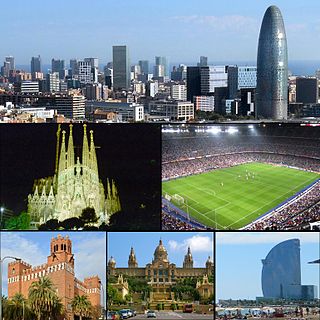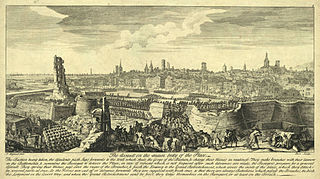
L'Hospitalet de Llobregat, often shortened to L'Hospitalet, is a municipality to the immediate southwest of Barcelona in Catalonia, Spain.

The Cathedral of the Holy Cross and Saint Eulalia, also known as Barcelona Cathedral, is the Gothic cathedral and seat of the Archbishop of Barcelona, Catalonia, Spain. The cathedral was constructed from the thirteenth to fifteenth centuries, with the principal work done in the fourteenth century. The cloister, which encloses the Well of the Geese was completed in 1448. In the late nineteenth century, the neo-Gothic façade was constructed over the nondescript exterior that was common to Catalan churches. The roof is notable for its gargoyles, featuring a wide range of animals, both domestic and mythical.

In heraldry, Saint George's Cross, also called the Cross of Saint George, is a red cross on a white background, which from the Late Middle Ages became associated with Saint George, the military saint, often depicted as a crusader.

The Senyera is a vexillological symbol based on the coat of arms of the Crown of Aragon, which consists of four red stripes on a yellow field. This coat of arms, often called bars of Aragon, or simply "the four bars", historically represented the King of the Crown of Aragon.

Barcelona is the capital of Anzoátegui State, Venezuela and was founded in 1671. Together with Puerto La Cruz, Lecheria and Guanta, Barcelona forms one of the most important urban areas of Venezuela with a population of approximately 950,000.

The Royal, Celestial and Military Order of Our Lady of Mercy and the Redemption of the Captives, also known as the Mercedarians, is a Catholic mendicant order established in 1218 by St. Peter Nolasco in the city of Barcelona, at that time in the Principality of Catalonia, for the redemption of Christian captives. Its members are most commonly known as Mercedarian friars or nuns. One of the distinguishing marks of the Order of the Blessed Virgin Mary of Mercy is that, since its foundation, its members are required to take a fourth vow: to die, if necessary, for another who is in danger of losing their faith. The Order exists today in 17 countries.

L'Ametlla de Mar, also called la Cala, is a municipality within the comarca of Baix Ebre, situated in the coastal region between the "Cap de Terme" and the "barranc de l'Àliga". It is limited to the south by the boundary with El Perelló, to the north-west with that of Tivissa, the Ebro riviera, and to the north-east with that of Vandellós and l'Hospitalet de l'Infant,

Saint Eulalia, co-patron saint of Barcelona, was a 13-year-old Roman Christian virgin who suffered martyrdom in Barcelona during the persecution of Christians in the reign of emperor Diocletian. There is some dispute as to whether she is the same person as Saint Eulalia of Mérida, whose story is similar.

The current flag of Barcelona combines the cross of Saint George, the patron saint of Catalonia, with the traditional red and yellow bars of the Senyera, the ancient symbol of the Crown of Aragon.
Eulalia is a feminine given name of Greek origin, Ευλαλια, meaning "well-spoken." It may refer to:

The Pennon of the Conquest is the flag raised by the Moors of Valencia, Spain, on September 28, 1238 on the tower of Alī-Bufāt, later called Torre del Temple, to indicate their surrender to the troops of king James I of Aragon. We know about this episode from the quote entered by the king himself in his Chronicle: "We were in the riverbed, between the gardens and the tower; and when we saw our flag upon the tower, we dismounted from our horse, and heading eastwards we cried from our eyes and kissed the earth for the great mercy God had made to us".

Line 1, shortened to L1, coloured red and often simply called Línia vermella, is the second oldest Barcelona Metro line, after line L3. It is the longest line of the Barcelona Metro, and links L'Hospitalet de Llobregat and Santa Coloma de Gramenet. Originally operated by the independent Ferrocarril Metropolitano Transversal de Barcelona, it is today operated by Transports Metropolitans de Barcelona (TMB) and is part of the ATM fare-integrated main transport system. L1 is the only metro line in Spain to use Iberian gauge tracks, as used by most Spanish main line railways.

In heraldry and vexillology, a heraldic flag is a flag containing coats of arms, heraldic badges, or other devices used for personal identification.

The flag of the Valencian Community and of the city of Valencia, known as Reial Senyera, is the traditional Senyera, composed of four red bars on a yellow background, crowned with a blue strip party per pale next to the spear with 1/4 of the total length. It was adopted on July 1, 1982.

La Mercè is the annual festival of the city of Barcelona in Catalonia, Spain. It has been an official city holiday since 1871, when the local government first organized a program of special activities to observe the Roman Catholic feast day of Our Lady of Mercy, La Mare de Déu de la Mercè in Catalan. Although the actual feast day is September 24, the festivities begin a few days beforehand.

Founded in 1886 by Barcelona City Council, the Barcelona Municipal Band is a musical institution going back a long way. Since 2007, it has been the resident band at the Barcelona Auditorium (L'Auditori), where it offers a fixed season of concerts and where it develops projects in partnership with artists and groups forming part of the international scene as well as those from the local sphere. The resident conductor since 2008 has been the Catalan composer and conductor Salvador Brotons.

The Plaça de Sant Jaume is a square at the center of the Old City of Barcelona and the administrative heart of both the city and surrounding Catalonia. This is because the Palace of the Generalitat of Catalonia and the City Hall are located here across from one another.

The Textile Museum and Documentation Centre is a museum institution located in Terrassa, a city with an important textile tradition. Managed by a consortium consisting of Terrassa Town Council and Diputació de Barcelona, it presents a panoramic view of the different styles and techniques used all over the world in fabric making throughout history. It is part of the Barcelona Provincial Council Local Museum Network.




















